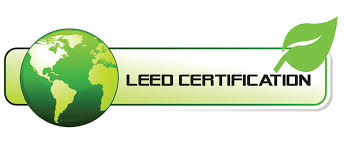 LEED, or “Leadership in Energy and Environmental Design,”
LEED, or “Leadership in Energy and Environmental Design,”
a set of standards that are used for the design, construction, and maintenance of buildings that are considered “green,” or environmentally responsible and efficient. LEED standards can not only help to reduce the impact that construction and building operations can have on the local environment and its population, but they are also important toward reducing energy costs for heating, cooling, and lighting, all of which can have enormous benefits for a property owner.
There are currently over 7,000 LEED projects within the United States and countries around the world, and LEED certification continues to be a very popular option for property owners that want to have a much less damaging impact on the environment. LEED buildings also mean lower energy costs throughout the year, which can be very important in areas that reach extremely high temperatures, extremely low temperatures, or both throughout the year.
LEED-certified contractors should be your first point of contact if you need repairs for a wide number of reasons, but among them is the familiarity with LEED that the contractor can bring to the work site. With minimal introduction, a LEED contractor can get to work on a green building much more readily than a contractor which isn’t at all familiar with LEED standards. What is surprising is there are very few LEED-certified disaster recovery contractors in the US.
What LEED Means
 In order to have a building certified with LEED, however, it’s important to work with contractors that are LEED certified themselves. Contractors who pass LEED certification must:
In order to have a building certified with LEED, however, it’s important to work with contractors that are LEED certified themselves. Contractors who pass LEED certification must:
- Comply with local standards for construction activity, which covers pollution prevention.
- Have a proper plan and protocol for waste management on a construction site.
- Use recycled materials where and when available, as well as regional materials to reduce the carbon footprint of construction or repair.
- Use sustainable, certified wood products.
- Manage indoor air quality both during construction and before the building will be occupied.
- Use low-emitting materials, which include certain sealants, paints, and coatings.
LEED contractors can not only help you to maintain these standards during any construction project but for repairs on a LEED-certified building as well. In fact, the best way to maintain your certification is to work with a LEED-certified contractor for the job. All subcontractors who work under that contractor must maintain the same standards that the contractor must abide by, which means that you’ll not only get top-quality work but you can also rest assured that all employees on the site will be aware of the proper LEED standards to follow.
 Why LEED Repairs are Vital
Why LEED Repairs are Vital
Choosing a LEED-certified, green building plan is a great way to help both the environment and your budget, but when you need repairs, it’s all the more important to maintain conservational and environmental concerns. Repairs to any building will still require building materials, monitoring of interior air control, use of recycled materials where available, and more. There will also need to be considerations for waste management, and for local laws and guidelines regulating any and all construction or repair work. LEED contractors must be fully aware of all of these criteria before they can even begin a job properly.
With a LEED contractor, you will get:
- More energy-efficient repair work, which includes repairs to roofing, insulation, and other aspects which can affect your energy usage.
- Green-oriented repairs to walls, flooring, and other areas, including the materials which are used.
- Savings on materials if you are using recycled matter from the same, or another, construction site.
- Long-term savings by having LEED systems properly repaired, maintained, or installed.
In both the short and long terms, having a LEED-certified contractor handling your repairs means savings, more productivity, and an overall more effective operation. If you are a LEED-certified contractor performing disaster mitigation, clean-up, and repairs, please contact me so I can add you to the list.
Types of LEED Certifications:
Green Building Design & Construction
- LEED for New Construction (Commercial)
- LEED for Core & Shell
- LEED for Schools
- LEED for Retail: New Construction and Major Renovations
- LEED for Healthcare
Green Interior Design & Construction
- LEED for Commercial Interiors
- LEED for Retail: Commercial Interiors
- Green Building Operations & Maintenance
- LEED for Existing Buildings: Operations & Maintenance
Green Neighborhood Development
- LEED for Neighborhood Development
Green Home Design and Construction
- LEED for Homes (Single-Family, Multifamily, and “Mid Rise”)
Dick Wagner Nationally recognized restoration sales coach and consultant. 419-202-6745
